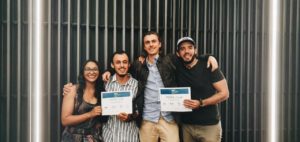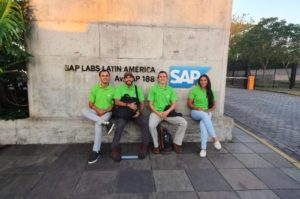Using tech to trace food’s path, from forest to table
In June, four EARTH University students entered a conference room buzzing with competitors. All participants of the German Development Service (GIZ)’s Hack The Farm competition sought the same goal: developing a data-collection system for biodiversity-promoting agricultural practices in the pineapple and banana sectors. Surprisingly, the EARTH fourth years were the only agronomy students at the competition. Recognizing the rich opportunity to collaborate with professionals from other disciplines – all related to technology – they set about learning from each other through constructive feedback. And they ended up winning the competition.
Malcolm Porteus González (’19, Costa Rica), Marco Oliveira Bellotti (’19, Brazil), Mastercard Foundation Scholar Raquel Guimaraes Alves (’19, Brazil) and Víctor Quezada Ramón (’19, Ecuador) toiled for 48 continuous hours to devise the most feasible solutions at the competition.
All teams were divided into a category, either senior (companies) or junior (students). Víctor and Raquel worked with the NW Consulting Services team; Marco and Malcolm worked with two students from Cenfotec University (Costa Rica). They were the perfect matches: EARTH students provided the vital agricultural knowledge while their teammates developed the software for a database and a user-friendly mobile app.
The EARTH students also had the chance to operationalize the findings from the research they conducted as part of their graduation projects. They had converted a swath of land – formerly used for grass production to feed livestock – within EARTH’s Guácimo Campus into a multistrata agroforestry system, with cacao as the primary cash crop. Having studied land-conversion techniques, Marco and Malcolm worked on spatial design, data collection and technical research. Raquel and Víctor dealt with the conversion’s socioeconomic components.
“We did a field study to assess the applied systems and learn about their productivity, efficiency, profitability and use of natural resources,” Víctor says. “We want to correctly measure so that a small producer can know how viable and profitable it is to apply a multistrata agroecological model. We want to also measure the environmental and socioeconomic impacts this model can have on a community.”
Unlike conventional agriculture, a multistrata system simulates the structure of a natural forest – taking into account the low, medium and high layers within agroforestry dynamics. This allows for greater productivity (more food output) and, at the same time, better protection of soils and biodiversity. In short, everyone wins: the producer, the consumer and nature.
The challenging and innovative work that Malcolm, Raquel, Víctor and Marco have been doing for months is beginning to bear fruit. With a few location-specific tweaks, their graduation projects can be replicated in other places.
As the winners of the Hack The Farm competition in both categories, all four had the opportunity to travel to Brazil to attend workshops sponsored by SAP, a multinational software company. From the competition to Brazil, the four of them emphasized the importance of technology in developing agroecological and agroforestry projects.
“In our proposals at Hack The Farm, we wanted to follow the route of a product from its origin in the field or forest, to the marketplace. For that, we used SAP systems to ensure the traceability of the products. It’s very important that the information reaching the consumer is clear, concise and not too technical,” Marco says. “During the workshop in Brazil, we learned that these systems serve to make people aware of consumption practices. Thanks to this experience, we believe that – by using an attractive and accessible mobile application – we can escape from the world of certifications and become more transparent.”
Through an alternative agroecological model and the sage use of data and technology, the four students hope to improve farming practices and consumption habits – and thereby transform entire communities.






